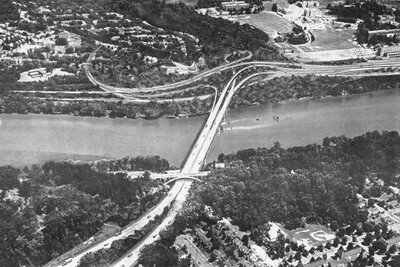From Richard Layman:
UnderSelling by not mentioning the potential linear park, let alone render that corridor to be more multi-model with an underground North Central Freewayhttp://urbanplacesandspaces.blogspot.com/2008/12/transportation-infrastructure-plan-for.html
Crazy Hard and Expensive Proposal
12. If you really want to spend money on infrastructure....
a. put the CSX Metropolitan Branch railroad underground.
b. There would have to be at least two levels of tunnel, for both the railroad -- three tracks -- and for the subway.
c. Make the subway tunnel two levels, or capable of carrying doublestack trains to double the capacity of the red line subway.
This one is so expensive that I won't put it in the priority list, but it could be done and would impact the region's and especially the city's competitive advantage for generations. See the blog entry, "Rethinking the Metropolitan branch railroad and subway tracks in northeast DC" for much more about this.
I have cut and pasted that below:
Rethinking the Metropolitan branch railroad and subway tracks in northeast DC
1. I find it interesting that last week's Current Newspapers announced in an editorial that Mayor Fenty has ordered a cessation of planning to remove the Whitehurst Freeway, something opposed by some but not all of the citizens groups in the Greater Georgetown neighborhood.
2. This is counter to the trend across the country, such as in San Francisco and Milwaukee, not to mention cities like Seoul, where this has already been done. Seattle probably will remove the Alaskan Way Viaduct as well (and there is no question that the Viaduct there cuts off the city from the water).

AP photo: Seattle's 2-mile-long Alaskan Way Viaduct.
See "15 SECONDS THAT CHANGED SAN FRANCISCO / The sweeping makeover that transformed the city began 15 years ago today with the Loma Prieta earthquake," by John King from the San Francisco Chronicle about removal of the Embarcadero Freeway and the subsequent positive impact.
Also see "Freeway Deconstruction and Urban Regeneration in the United States," a paper from the University of California Transportation Institute and the webpage "Removing Freeways, Restoring Cities."
3. At the Congress for the New Urbanism meeting in Philadelphia there was a session on removing freeways along riverfronts. Michael Lewyn has some notes about the session in his blog. From the entry:
Jeff Tumlin asserted that freeways export real estate value from cities to suburbs; their absence maximizes cities' property value. He used Vancouver as an example of life without freeways: while downtown vehicle trips increased in every other Canadian city since 1995, such trips decreased in Vancouver- even while total trips (including walking/transit/bike trips) increased by 22%!
4. Plus, the City is removing part of the Frederick Douglass Bridge on South Capitol Street, putting more of the roadway at grade, and restoring the street grid in that area. See "Dead End at the Anacostia," subtitled "Two-Month Project Will Complicate Life for 77,000 Douglass Bridge Commuters" from the Washington Post, and ignore the focus on the very short term inconvenience to commuters. Instead focus on how the area will be improved by the reduction of the amount of aerial freeway span and the restoration of the grid.
From the article:
The bridge repairs are being done to extend the life of the span until a new bridge is built. The $27 million project also will allow the new bridge to be built and connected to the street grid without major interruptions, officials said.
About 400 feet of bridge will be eliminated on the northern side of the crossing and 200 feet will be lowered about 10 feet so the span touches down at Potomac Avenue. As part of the project, the stretch of South Capitol Street just north of the bridge will become a tree-lined boulevard.
Click here for the complete Washington Post graphic about the South Capitol Bridge project.
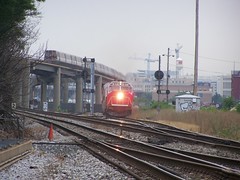
MARC train and subway at Rhode Island Avenue Station
5. In the context of the current underway Brookland Small Area Plan, some of the residents have come up with an alternative suggesting that the railroad and subway tracks and subway station be "depressed" or decked, and the street grid be restored in the area between the two railroad bridge overpasses at Monroe and Michigan Avenues.
(In a conversation last night with a colleague he mentioned that it is not possible from an engineering to depress the railroad tracks for that depth for such a short distance. Railroad locomotive engines like even grades.)

MARC train north of the Rhode Island Avenue Subway Station
But after reading the piece about the re-configuring of the South Capitol Street bridge, to remove one span and put the street back in and on the grid, I have been thinking that it doesn't reach far enough. The Brookland "alternative proposal" doesn't suggest extending this idea and removing the bridges.
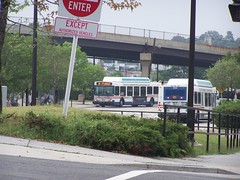
Looking at the Michigan Avenue Bridge, Brookland

Monroe Street bridge, Brookland

Monroe Street bridge and the streetcar, Joe Testagrose Collection.
6. Extending this idea further, like the Reno Retrac project or the creation of the Alameda Transportation Corridor to connect the Ports of Long Beach and Los Angeles, how about putting the railroad tracks and subway tracks and subway stations below grade, from the Rhode Island Metro Station to perhaps as far as the Silver Spring Metro Station? Definitely to Takoma.
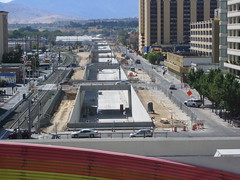
Reno Retrack project. Image by JBR Environmental Consultants.
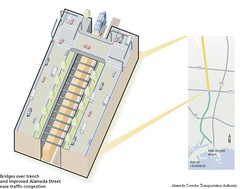
Mid-corridor tunnel, Alameda Transportation Corridor.
Both the Reno and Alameda Corridor projects created ditches. (See "The Train Line" for more about the LA project, and the City of Reno website on the Retrac project, including a section on the history of the project.) Instead, I suggest creating the ditch and covering it over, and restoring the street grid.
At Rhode Island Station, the subway tracks are high high above the street, but starting somewhat south, around the big Post Office Complex off Brentwood Road, the tracks could begin to go underground, instead of climbing up very very high. (The tracks start rising just south of the equivalent of T Street NE, around the WMATA maintenance facility.)
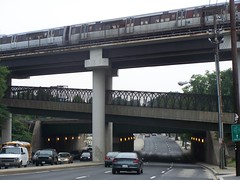
Subway bridges over Rhode Island Avenue NE, looking west

Corner of T and 5th Streets NE, adjacent to Sanitary Grocery, near the beginning of the rise of the subway track bridge
Around Franklin Street NE, the tracks go back to grade and a little further they even go underground a bit, where one of the railroad tracks cuts over to the east, and from that point going north for a ways, the railroad tracks bracket the red line subway tracks. 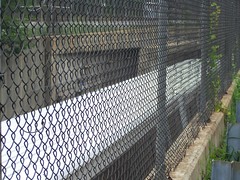
Metro tunnel heading north to Brookland around Girard Street at 9th Street NE.
At the very least, it could be done in Brookland, say from Franklin Street up to Ft. Totten. By Franklin the tracks come down to grade or below anyway, from very high up at Rhode Island Station.

Lawrence Street stub at 9th Street NE
7. Another example would be the proposal for a Tysons Corner tunnel, which proposed a two level tunnel, using Spanish technology.

This idea could be further extended, and a two tunnel system could be created to separate the railroad from the subway.
See this blog's articles on the
Grand Arc Mall Tunnel
